The AMD Radeon R9 Fury Review, Feat. Sapphire & ASUS
by Ryan Smith on July 10, 2015 9:00 AM ESTMeet The Sapphire Tri-X R9 Fury OC
Today we’ll be looking at Fury cards from both Sapphire and Asus. We’ll kick things off with Sapphire’s card, the Tri-X R9 Fury OC.
| Radeon R9 Fury Launch Cards | |||||
| ASUS STRIX R9 Fury | Sapphire Tri-X R9 Fury | Sapphire Tri-X R9 Fury OC | |||
| Boost Clock | 1000MHz / 1020MHz (OC) |
1000MHz | 1040MHz | ||
| Memory Clock | 1Gbps HBM | 1Gbps HBM | 1Gbps HBM | ||
| VRAM | 4GB | 4GB | 4GB | ||
| Maximum ASIC Power | 216W | 300W | 300W | ||
| Length | 12" | 12" | 12" | ||
| Width | Double Slot | Double Slot | Double Slot | ||
| Cooler Type | Open Air | Open Air | Open Air | ||
| Launch Date | 07/14/15 | 07/14/15 | 07/14/15 | ||
| Price | $579 | $549 | $569 | ||
Sapphire is producing this card in two variants, a reference clocked version and a factory overclocked version. The version we’ve been sampled is the factory overclocked version, though other than some basic binning to identify cards that can handle being overclocked, the two cards are physically identical.
As far as Sapphire’s overclock goes, it’s a mild overclock, with the card shipping at 1040MHz for the GPU while the memory remains unchanged at 1Gbps. As we discussed in our R9 Fury X review, Fiji cards so far don’t have much in the way of overclocking headroom, so AMD’s partners have to take it easy on the factory overclocks. Sapphire’s overclock puts the upper-bound of any performance increase at 4% – with the real world gains being smaller – so this factory overclock is on the edge of relevance.
Getting down to the nuts and bolts then, Sapphire’s card is a semi-custom design, meaning Sapphire has paired an AMD reference PCB with a custom cooler. The PCB in question is AMD’s PCB from the R9 Fury X, so there’s little new to report here. The PCB itself measures 7.5” long and features AMD’s 6 phase power design, which is designed to handle well over 300W. For overclockers there is still no voltage control options available for this board design, though as Sapphire has retained AMD’s dual BIOS functionality there’s plenty of opportunity for BIOS modding.
The real story here is Sapphire’s Tri-X cooler, which gets the unenviable job of replacing AMD’s closed loop liquid cooler from the R9 Fury X. With a TBP of 275W Sapphire needs to be able to dissipate quite a bit of heat to keep up with Fiji, which has led to the company using one of their Tri-X coolers. We’ve looked at a few different Tri-X cards over the years, and they have been consistently impressive products. For the Tri-X R9 Fury, Sapphire is aiming for much the same.
Overall the Tri-X cooler used on the Tri-X R9 Fury ends up being quite a large cooler. Measuring a full 12” long it runs the length of the PCB and then some, meanwhile with that much copper and aluminum it’s not a light card either. The end result is that with such a large cooler the card is better defined as a PCB mounted on a cooler than a cooler mounted on a PCB, an amusing juxtaposition from the usual video card. As a result of this Sapphire has gone the extra mile to ensure that the PCB can support the cooler; there are screws in every last mounting hole, there’s a full-sized backplate to further reinforce the card, and the final 4.5” of the cooler that isn’t mounted to the PCB has its own frame to keep that secure as well.
Moving to the top of the card, the Tri-X R9 Fury features three of Sapphire’s 90mm “Aerofoil” fans, the company’s larger, dual ball bearing fans. These fans are capable of moving quite a bit of air even when moving at relatively low speeds, and as a result the overall card noise is kept rather low even under load, as we’ll see in full detail in our benchmark section.
Meanwhile Sapphire has also implemented their version of zero fan speed idle on the Tri-X R9 Fury, dubbed Intelligent Fan Control, which allows the card to turn off its fans entirely when their cooling capacity isn’t needed. With such a large heatsink the Fiji GPU and supporting electronics don’t require active cooling when idling, allowing Sapphire to utilize passive cooling and making the card outright silent at idle. This is a feature a number of manufacturers have picked up on in the last couple of years, and the silent idling this allows is nothing short of amazing. For Sapphire’s implementation on the Tri-X R9 Fury, what we find is that the fans finally get powered up at around 53C, and power down when the temperature falls below 44C.
| Sapphire Tri-X R9 Fury Zero Fan Idle Points | ||||
| GPU Temperature | Fan Speed | |||
| Turn On | 53C | 27% | ||
| Turn Off | 44C | 23% | ||
Helping the cooling effectiveness of the Tri-X quite a bit is the length of the fans and heatsink relative to the length of the PCB. With the 4.5” of overhang, the farthest fan is fully beyond the PCB. That means that all of the air it pushes through the heatsink doesn’t get redirected parallel to the card – as is the case normally for open air cards – but rather the hot air goes straight through the heatsink and past it. For a typical tower case this means that hot air goes straight up towards the case’s exhaust fans, more efficiently directing said hot air outside of the case and preventing it from being recirculated by the card’s fans. While this doesn’t make a night & day difference in cooling performance, it’s a neat improvement that sidesteps the less than ideal airflow situation the ATX form factor results in.
Moving on, let’s take a look at the heatsink itself. The Tri-X’s heatsink runs virtually the entire length of the card, and is subdivided into multiple segments. Connecting these segments are 7 heatpipes, ranging in diameter between 6mm and 10mm. The heatpipes in turn run through both a smaller copper baseplate that covers the VRM MOSFETs, and a larger copper baseplate that covers the Fiji GPU itself. Owners looking to modify the card or otherwise remove the heatsink will want to take note here; we’re told that it’s rather difficult to properly reattach the heatsink to the card due to the need to perfectly line up the heatsink and mate it with the GPU and the HBM stacks.
The Tri-X R9 Fury’s load temperatures tend to top out at 75C, which is the temperature limit Sapphire has programmed the card for. As with the R9 Fury X and the reference Radeon 290 series before that, Sapphire is utilizing AMD’s temperature and fan speed target capabilities, so while the card will slowly ramp up the fan to 75C, once it hits that temperature it will more greatly ramp up the fan to keep the temperature at or below 75C.
Moving on, since Sapphire is using AMD’s PCB, this means the Tri-X also inherits the former’s BIOS and lighting features. The dual-BIOS switch is present, and Sapphire ships the card with two different BIOSes. The default BIOS (switch right) uses the standard 300W ASIC power limit and 75C temperature target. Meanwhile the second BIOS (switch left) Increases the power and temperature limits to 350W and 80C respectively, for greater overclocking limits. Note however that this doesn’t change the voltage curve, so Fury cards in general will still be held back by a lack of headroom at stock voltages. As for the PCB’s LEDs, Sapphire has retained those as well, though they default to blue (sapphire) rather than AMD red.
Finally, since this is the AMD PCB, display I/O remains unchanged. This means the Tri-X offers 3x DisplayPorts along with a single HDMI 1.4 port.
Wrapping things up, the OC version we are reviewing today will retail for $569, $20 over AMD’s MSRP. The reference clocked version on the other hand will retail at AMD’s MSRP of $549, the only launch card that will be retailing at this price. Finally, Sapphire tells us that the OC version will be the rarer of the two due to its smaller run, and that the majority of Tri-X R9 Fury cards that will be on sale will be the reference clocked version.


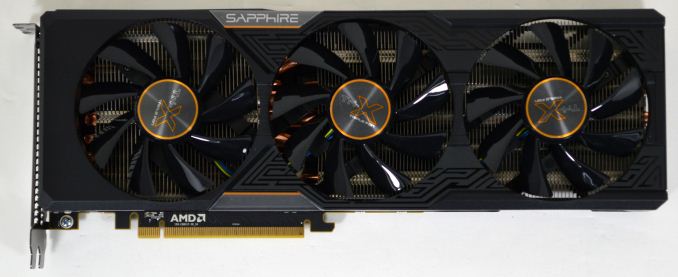
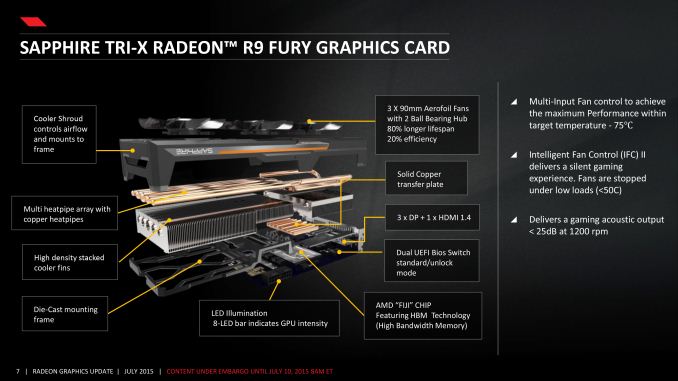
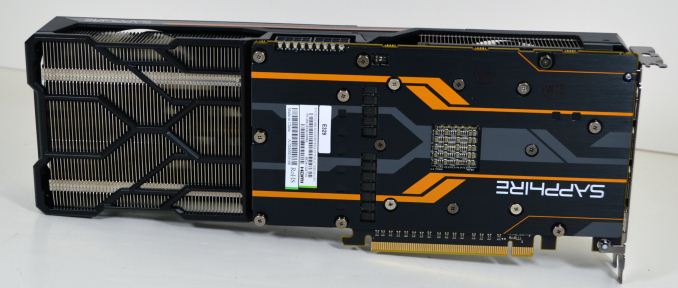
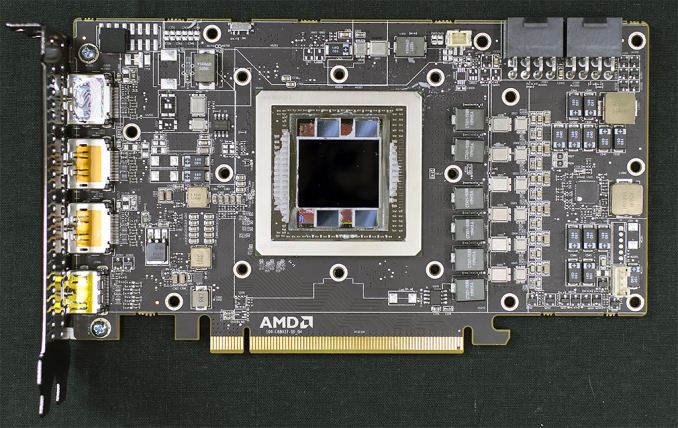


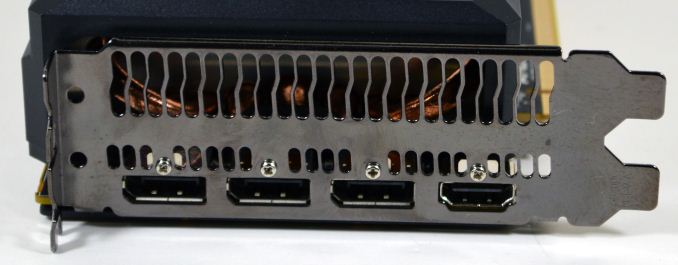








288 Comments
View All Comments
Gigaplex - Saturday, July 11, 2015 - link
"We do not compare OC'd cards."Well, technically you do, but usually only when there's no reference card. Problem is, if one vendor decides not to do a reference card, the custom cards get an advantage when comparing against reference cards of another vendor. We're only asking that you include a custom card as well in these situations.
Ryan Smith - Saturday, July 11, 2015 - link
Whenever there isn't a reference card however, we always test a card at reference clockspeeds in one form or another. For example in this article we have the ASUS STRIX, which ships at reference clockspeeds. No comparisons are made between the factory overclocked Sapphire card and the GTX 980 (at the most we'll say something along the lines of "both R9 Fury cards", where something that is true for the ASUS is true for the Sapphire as well).And if you ever feel like we aren't being consistent or fair on that matter, please let us know.
Ranger101 - Saturday, July 11, 2015 - link
Nvidia still has the fastest high end offering in the 980TI. Isn't that enough? Sometimes you just have to take a solid AMD win on the chin.Socius - Saturday, July 11, 2015 - link
Except a card that is $100 more than the GTX 980, and slower than it when OC'd, isn't a "win" by any means. Unless we're treating AMD like they're in the special Olympics and handing them a medal just for showing up.FlushedBubblyJock - Wednesday, July 15, 2015 - link
I know, rofl.The amd fanboy forgets pricing suddenly, when their master and god reams the backkside wallet holder, suddenly price is removed entirely from the equation !
It's no secret amd fanboys are literally insane from their obsession.
Socius - Saturday, July 11, 2015 - link
Really? The Fury is ahead of the GTX 980 and is a comparable value proposition? Yet again you run overclock benches with the Fury without showing the same being done on that GTX 980. I have no idea why you follow this policy of no cross-vendor OC performance comparisons as most people geeky enough to be reading this website would be interested in seeing final performance stats that they can achieve on a stock card, with basic overclocking. So if you have a card like the Fury that overclocks a whopping 5%, compared to a GTX 980 that can overclock 25-40%, yeah...you're doing a disservice to your readers by withholding that information. Especially when you don't even bring it up in your conclusion.Paid by AMD much? I never thought I'd have to look at any reviews other than those from Anandtech. But this website has been playing it too cautiously, and without the ultimate intent of showing best overall/actual performance and value to their readers.
Seriously Ryan, I'm disappointed. I don't see why there would be an issue with showing a comparison between max OC between, oh, let's say, the Asus R9 Fury STRIX and the...Asus GTX 980 STRIX. Would be a pretty darn fair comparison of 2 different cards and their performance when given the same treatment by the same manufacturer.
I don't know why I even bother commenting anymore.
Orthello - Saturday, July 11, 2015 - link
I think it would be great to see an OC vs OC comparison, the problem is its unfair to do so now for Fury as there is no voltage control yet like there is for Nvidia Cards.When afterburner / trixx etc support the voltage control for Fury then we can really get the real max oc vs max oc , unless you are talking about overclocks at defualt voltage which makes no sense.
Socius - Saturday, July 11, 2015 - link
At the end of the day, this is the product they've placed in people's hands. But even without voltage increases on the Nvidia side, you should be able to OC to around 1400MHz at least, when on a custom cooler design like the STRIX model, for example. But I don't think Ryan cares about what's "fair." That's why he's putting these custom boards up against the reference NVidia designed/clocked GTX 980. Because that's somehow a fair comparison. =DFlushedBubblyJock - Wednesday, July 15, 2015 - link
Don't worry, the insanity is so rampant that if amd ever gets an overclock going- we will never hear the end of it - "OVERCLOCK MONSTER !!!!"On the 290 series amd fanboys were babbling all over the internet that nearly every amd card hits 1300 or 1350 "easily".
Of course they were lying those were rare exceptions, but hey...losing is hard on the obsessed.
Now we know the nvidia flagship core is a real monster overclocker, so we should not mention it ever, nor hear about it, nor factor it in at all, EVER FOR ANY REASON WHATSOEVER.
Frankly I can't get away from the sickly amd fanboys, it's so much entertainment so cheap my sides have never been busted so hard.
Ranger101 - Saturday, July 11, 2015 - link
If quality articles that provide a balanced perspective disappoint you that's a shame. Take comfort in knowing the 980TI is currently still the fastest card. Allow me to once again commend Anandtech on an excellent article.